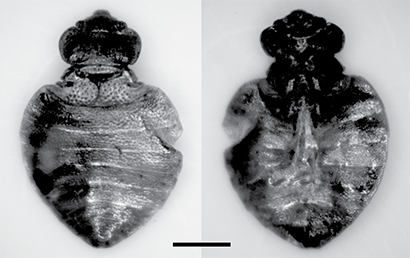

| Online: | |
| Visits: | |
| Stories: |

| Story Views | |
| Now: | |
| Last Hour: | |
| Last 24 Hours: | |
| Total: | |
11,000 Year Old Bed Bugs: Oldest Ever Found in North America
In research published this week in the Journal of Medical Entomology, a pair of archaeologists describe remains found in caves near Paisley, Oregon, that represent the oldest specimens of insects from the genus Cimex ever found, ranging between 5,100 and 11,000 years old.
The remains were identified as relatives of the bed bug, Cimex lectularius, but they were “not the bed bug we all know and love from hotel rooms,” says Martin E. Adams of Paleoinsect Research and co-author on the study with Dennis L. Jenkins of the Museum of Natural and Cultural History at the University of Oregon. The species in the Paisley Five Mile Point Caves (Cimex pilosellus, Cimex latipennis, and Cimex antennatus) are all parasites of bats.Several specimens such as this Cimex latipennis female found in the Paisley Caves in Oregon date nearly 11,000 years ago.
Cimex lectularius and Cimex hemipterus are the two bed bug species known to parasitize humans, widely believed to have adapted to that role thousands of years ago when humans shared caves with bats in Europe, Asia, and Africa. The species found in the Oregon caves, however, never made that jump, and Adams says it’s unclear why not.
“Were the cimicid populations too small to establish themselves outside the caves, or were the host populations too small?” Adams says. “Given that Paisley Caves was only a seasonal occupation area for human hunter-gatherers, did the humans move around too much, or were the bugs not able to withstand the environment outside the caves for very long? Or, were there other constraints involved? I’m working on these last few archaeological questions right now.”
The identification of the three Cimex species may also offer some clues to climactic trends during the eras they were dated to, Adams says. Cimex antennatus, for instance, tends to favor the warmer climates of California and Nevada. “The presence of warm-tolerant cimicids in the caves, such as Cimex antennatus, may suggest that climatic conditions at Paisley Caves 5,100 years ago were similar to what Cimex antennatus enjoys today in its current range.”
Joe Rominiecki
Journal of Medical Entomology
Source: http://www.ineffableisland.com/2017/04/11000-year-old-bed-bugs-oldest-ever.html



